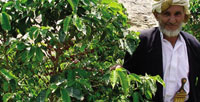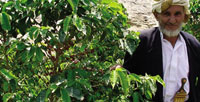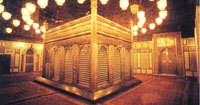
Haraz trades qat for coffee farming [Archives:2008/1164/Reportage]
June 16 2008
 |
Though qat farming is the main source of income for many Yemenis in rural areas because of its high market value, villagers in Haraz are leaving qat behind and going back to their traditional crop: coffee beans.
A study by the Ministry of Agriculture in 2001 estimated that the income from cultivating qat in Yemen was about YR 2.5 million per hectare, while it was only around YR 570,000 per hectare for fruits. This provides strong motivation for farmers to choose qat over other crops. For this reason, qat cultivation grew from 8,000 hectares to 103,000 hectares between 1970 and 2000. However, these numbers are crude estimates and the real figures are believed to be much higher, according to Yemeni agricultural researchers. However, qat farming causes destruction to the soil, robbing it of nutrients and the scarce supply of water.
The idea to shift from planting qat to planting coffee originated with Shabbir Al-Ezzi, when he and his wife Um Hani were visiting their relatives' village in the Haraz Mountains. Realizing the need for change and envisioning the opportunity to restore commercial agriculture to the region, Al-Ezzi started the Haraz Project. Al-Ezzi developed an idea to implement a range of good commercial and community-based business practices through coffee farming.
\”Disillusioned farmers had no incentive to produce coffee


